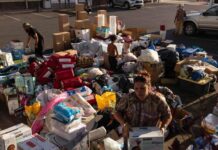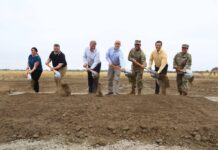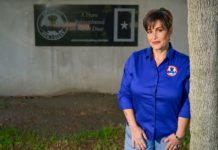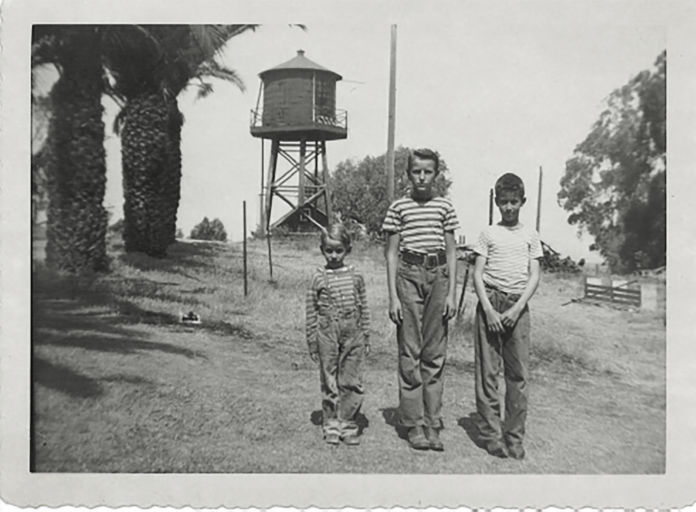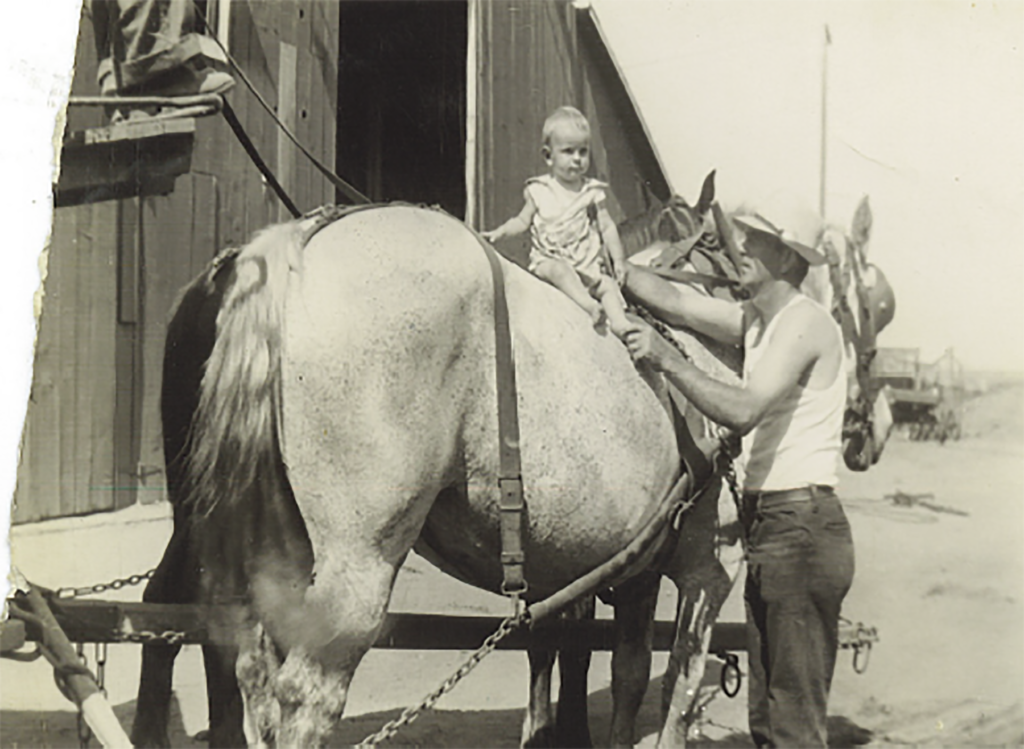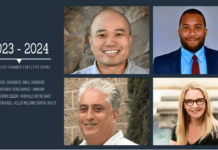For its first fifty or so years, Seal Beach (Bay City) was just the Old Townj tract of land south of current Pacific Coast Highway from Anaheim Landing to the Orange County line. Everything north of there until you reached Garden Grove Boulevard was the I.W. Hellman Ranch. It is now the site of the Naval Weapons Station (built in 1944), the homes on The Hill (1952-57), Leisure World (1961-63), the North American Rockwell/Boeing Company campus (1962), the Police Department, and finally Heron Point. (2002).
Prior to its development, the Hellman Ranch was its own self-sustaining community. One person who knew it intimately was Hugh Tyler, whose father was a long-time foreman on the old Hellman ranch from the 1930s until its closure when the last of its land was sold to North American Rockwell. Hugh Tyler basically grew up on the ranch. He and I first spoke around 2012 when I was doing research for my book, Seal Beach: A Brief History, and he recently called me to say he had written a memory of his days growing up on the ranch and asked if I would take a look at it for him, fill in some gaps, and if I found it worthy to make sure it was made available to people interested in those days. Below is his original story. I have only added a few notes to correct some facts he would have no way of knowing.
The Hellman Ranch property at Seal Beach, California was purchased by I. W. Hellman
in 1886. It was virgin land that had to be drained, cleared, and developed for cultivation. [note] Technically, Hellman — who is the banker who built Wells Fargo into a national institution — financed John W. Bixby’s purchase of the entire Rancho Los Alamitos in 1881, along with John W.’s older cousins, Lewellyn and Jotham Bixby who owned the adjoining Rancho Los Cerritos. When J.W. died suddenly in 1887, the Alamitos was divided into four parcels. Together they would own and operate the newly laid-out town of Alamitos Beach – present Long Beach south of present PCH (this became the Alamitos Land Co.); and the remaining acreage was split into equal thirds. Except for a little spit of land that is now Old Town Seal Beach, Hellman received all the Orange County land south of current Garden Grove Boulevard.[/note]
Most of the work was done using horse-drawn equipment. There was one self-propelled steam-powered machine that was used to excavate the many drainage ditches that were
required. This steam shovel fell into disuse after the clearing job was finished and rested as a derelict on the ranch until the need for scrap iron developed at the beginning of WW
II. It was sold and hauled away.
The Ranch at Seal Beach was developed to provide feed for beef cattle that the Hellman company was breeding and raising on range land on their thirty five thousand acre
Nacimiento Ranch near Paso Robles, California. The cattle would be raised on the Nacimiento Ranch then trucked to the Ranch at Seal Beach to be fattened for the Los
Angeles market. When properly prepared the cattle would be trucked to the Cudahay slaughter house in Los Angeles. [note]In the early years cattle were also marched to the yards at Los Alamitos to be fattened on the sugar beet tops mixed with molasses and on barley stubble. Sometimes they were then loaded onto railroad cars there, (and sometimes driven up the riverbeds) and taken to the slaughterhouses at Cudahy.[/note]
The ranch land was divided into large parcels. These parcels were farmed mostly by
immigrant farmers who worked part of their parcels as a cash crop for themselves and
the rest of the parcel was used to produce barley hay for the cattle. One of the largest
cash crops was sugar beets. There were sugar beet processing plants in Los Alamitos
and Santa Ana. [note]Early on there were five sugar plants in Orange County- Los Alamitos, Huntington Beach, Anaheim and two in Sana Ana. By 1920, it was just Los Al and Santa Ana, and after 1927, Los Al closed down but its management took over the larger, newer Santa Ana plant off Dyer Road and the present 55 freeway.[/note]
Homes, barns, water wells, and other outbuildings were built for the farmers. Each had his own individual place. Some of the family names I remember
are, Joe DeSadaleer, Rene Quaticar, Emil Goosen, August Kanoe, DePatter Paul Lerno and Van de Velde. There were others whose names I cannot recall. There were also
Japanese families living on the ranch near Seal Beach who raised vegetables on the land allocated to them. They did not raise barley hay. ( Note: The above names may not be
spelled correctly. )
Joe DeSadaleer’s son Homer was well known to my family. My father knew him as a young lad who spent a lot of time studying and attending to the medical condition of his
father’s animals. Homer went on to attend UCLA and became a Medical Doctor. He set up his office in Seal Beach and for many years was the only doctor in town. He was
highly respected and indeed became our family doctor.
[2]
When the ranch was in full operation a large crew of men was necessary to haul the baled hay to the feed barn and storage barns on the main ranch from the fields where it
was baled. The hay taken to the feed barn was run through a chopper and blown through large sheet metal pipes into the storage areas in the center of the barn using air pressure.
Chopped hay is much easier to move from the storage area to the mangers than if it had not been chopped. Throughout the year, subsequent to harvest time, baled hay had to be
moved from the storage barns to the feed barn and run through the chopper. The entire feeding operation was done by hand and was very labor intensive. The cattle were kept
away from the mangers by use of an electric fence wire which could be moved upward to allow them to pass under it after their food had been placed in the mangers. Barley
hay was the basic food and supplementary purchased foods were added to it.
Some of the tenant farmers were raising sugar beets as a cash crop. My brother Ernest Tyler recently told me that our father had told him that beet tops seemed to be an ideal
supplement to the diet of the cattle but they would not eat it. It was too bitter for them. They had no objection to the beet tops however when molasses was added to them. A
large tank was placed in the center of the feed barn and when beet tops were placed in the mangers, molasses was poured over them.
The cattle feeding operation ended when the U.S. Navy took over most of the farmland for the Naval Ammunition and Net Depot at Seal Beach at the beginning of WW II.
As a result of the naval takeover the Hellman Company was faced with how to best use the remaining ranch property. It was determined at that time to continue management
of the property under the direction of Mr. Frank Crowley who had so successfully managed the cattle business. [note] Before Crowley, Fred H. Bixby, who owned the adjacent ranch to the north had been managing the Hellman’s Seal Beach operation as well as their Nacimiento one. Nixby did this through at least 1926.[/note] He became a farm manager and after purchasing the necessary equipment the company began farming several hundred acres of the remaining land. He kept only three of the original employees and hired temporary help as needed during the summers. The farming operation continued until 541 acres of the best farmland were sold to the developers of Rossmoor Leisure World in 1961. The old ranch buildings fell into disuse but continued to exist for many years until the property they were built on was sold to an aerospace company. The land is now occupied by the Boeing Company and there is no longer any physical evidence of the existence of the ranch buildings at that location.
[3]
The ranch buildings were built on high ground about a mile and a half from the coast highway on what is now called Seal Beach Boulevard. The entry driveway ran between
the horse barn and a long tool shed built for storage of farm equipment. The tool shed also had a very functional blacksmith shop included in one end. Continuing past the
tool shed the driveway passed by a tack storage building on the left where saddles, bridles, and other necessities for riding horses were stored. On the right was a small
building for storage. Behind that storage building were two small houses. Next to that building was a garage that my uncle used for his car. His house was immediately
behind the garage. The next building on the right was a two-story bunkhouse which housed some of the working crew during the early operation of the ranch when local
roads and housing were very limited.
Beyond the bunkhouse the driveway circled to the left and then continued back down toward the rear of the tool shed and finally ended up by intersecting with the main entry road near Seal Beach Blvd. This created an oval driveway which was lined on both sides with palm trees. At the point where the driveway curved to form the return to the highway stood the cookhouse which had a small office in it and a large dining room and kitchen where food was prepared for the ranch personnel, workers and management as well. The ranch cook, Mrs. Freeman, lived in the house which included two bedrooms and a bathroom for her personal use.
There was a large parking area to the right of the cookhouse. Near the cookhouse stood a chicken house where chickens were kept for egg production. A redwood water tank
atop a wooden supporting structure provided water storage for the people on the ranch as well as all of the animals. The water tank was kept full by pumping water from a large
very deep well near the tank. Behind the tool shed stood two very large storage barns for baled hay. They were very tall, had metal roofs, and were sided on the upper half only
with sheet metal. The lower portions of the sides and ends were left open for air circulation.
A huge feed barn was located behind the horse barn. It had large corrals to contain the cattle being fed there. To achieve vehicular access to the feed barn a road ran between
the horse barn and the small storage building. The road ran on beyond the feed barn for a long distance where a Stud barn was built to the left of the road and further on down
the road to the right was another feed storage barn. On the left of the road in front of the feed barn was another housing area where three houses were built for family housing.
This road intersected with another road which ran between the horse barn and the feed barn. On this road, after passing through a gate, one could drive through the horse
pasture beyond which were the cultivated fields that became Rossmoor Leisure World.
[4]
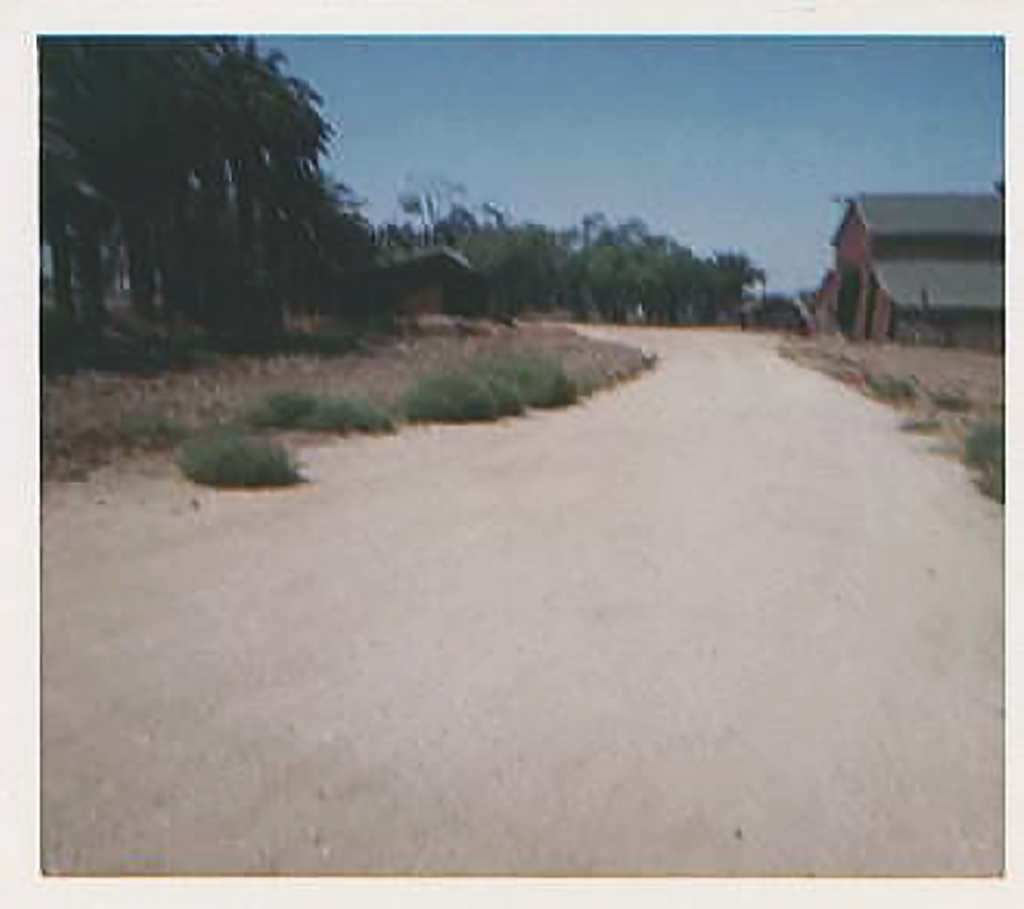
MAIN DRIVEWAY TO THE RANCH
This photo shows the main entrance to the Ranch. On the left is the tool shed and on the right is the Horse Barn. To the left of the road and behind the palm trees were two large
barns for storage of baled hay. Straight on up the driveway beyond the olive, pepper,
and palm trees was the cook house.
Another road intersected with this one at the horse barn and went to the right to the feed
barn and beyond.
[5]
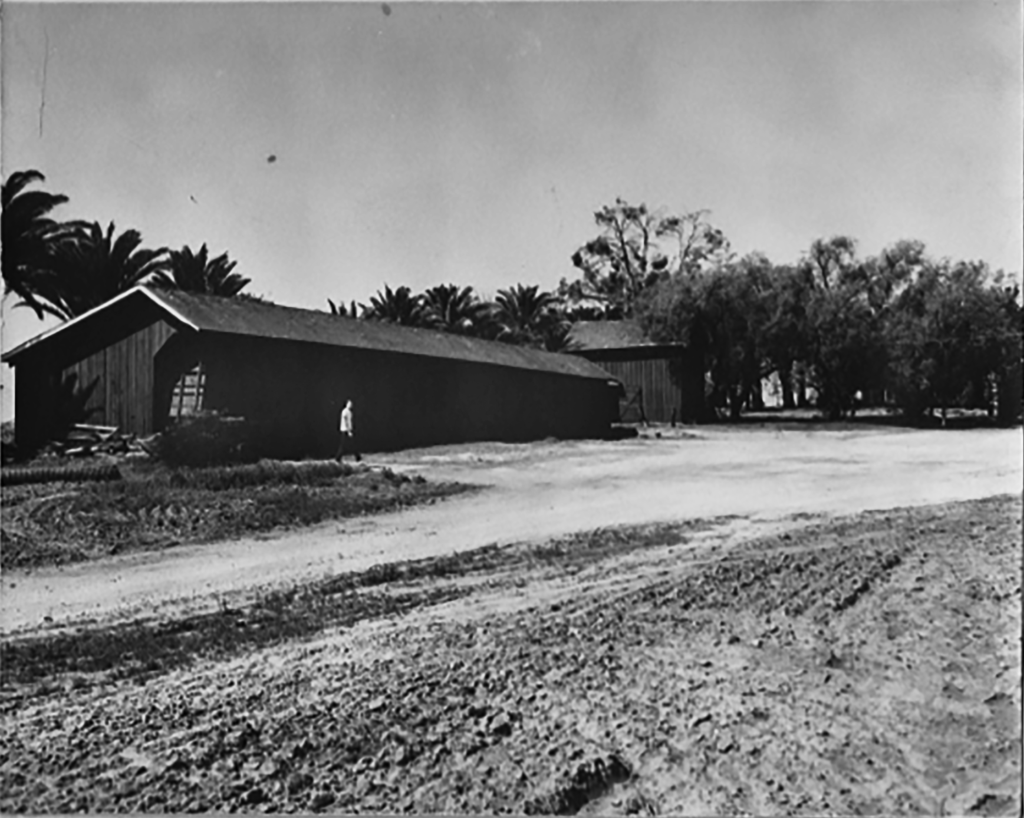
TOOL SHED
The first parking stall was where the 1937 GMC flatbed truck was parked. This
truck was used to haul cattle from the Nacimiento Ranch to the Seal Beach
Ranch. There was also a 4 wheel trailer which was pulled by this truck. When the
Navy took over most of the Ranch the tool shed housed three small rubber tired
tractors for cultivation and mowing the land that was farmed by ranch hands who
were now farmers. In the far end of the tool shed was a large well-equipped
blacksmith shop. When needed, Mr. Washington would come to the ranch to
perform whatever was needed of a blacksmith.
Just beyond the end of the tool shed was the storage room for the saddles,
bridles, and other articles needed for riding horses. There was a long metal hitch
rail in front of this building so that horses could be tied up while being prepared
for riding.
[6]
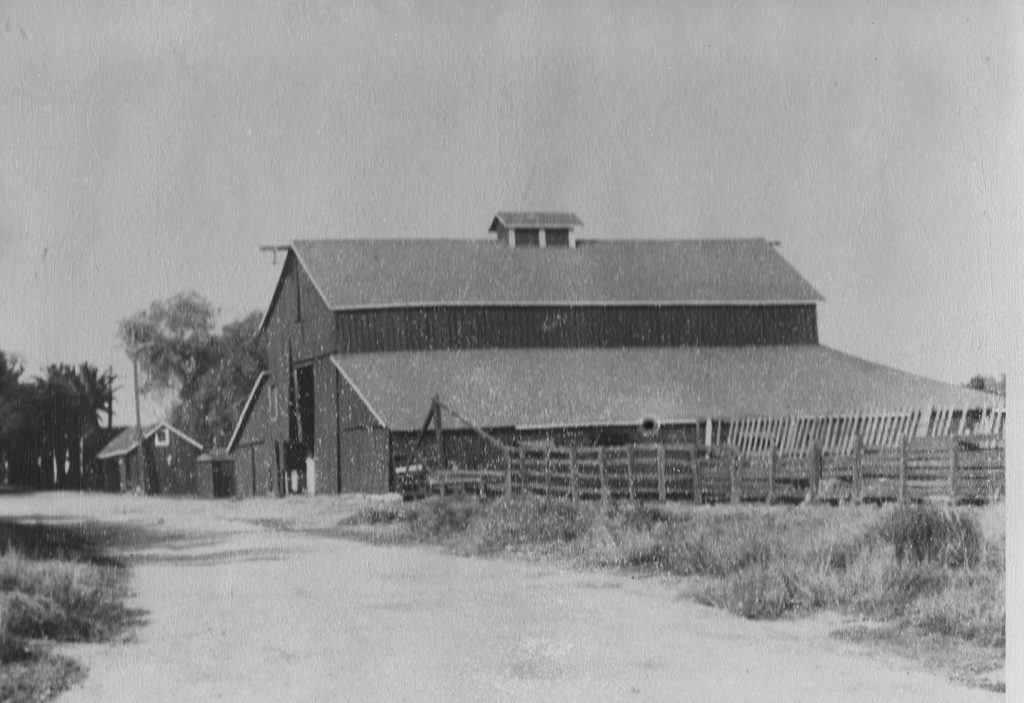
HORSE BARN
The horse barn was used to house work horses and riding horses. The entire
center portion of the barn was for hay storage and the outer edges were where
the horses were kept when not working. In the summers the horses were mostly
kept in the large corral seen in the photo. At the back of the barn not visible in
the photo was a small area where the dairy cows were milked by hand twice daily
by Louis Cruz who lived with his family in a house provided by the ranch. When it
was decided to grow barley and harvest the grain. A harvester was purchased to
separate the grain from the chafe. It had to be stored somewhere and the horse
barn was selected for that purpose. Boards were removed at the top of the door
to enable getting it into the barn. Two TD9 International caterpillar tractors were
used for plowing and other chores. These tractors were housed in a rear area of
the horse barn. Just beyond the horse barn is a small storage building behind
which two small houses were built to house the families of ranch hands.
[7]
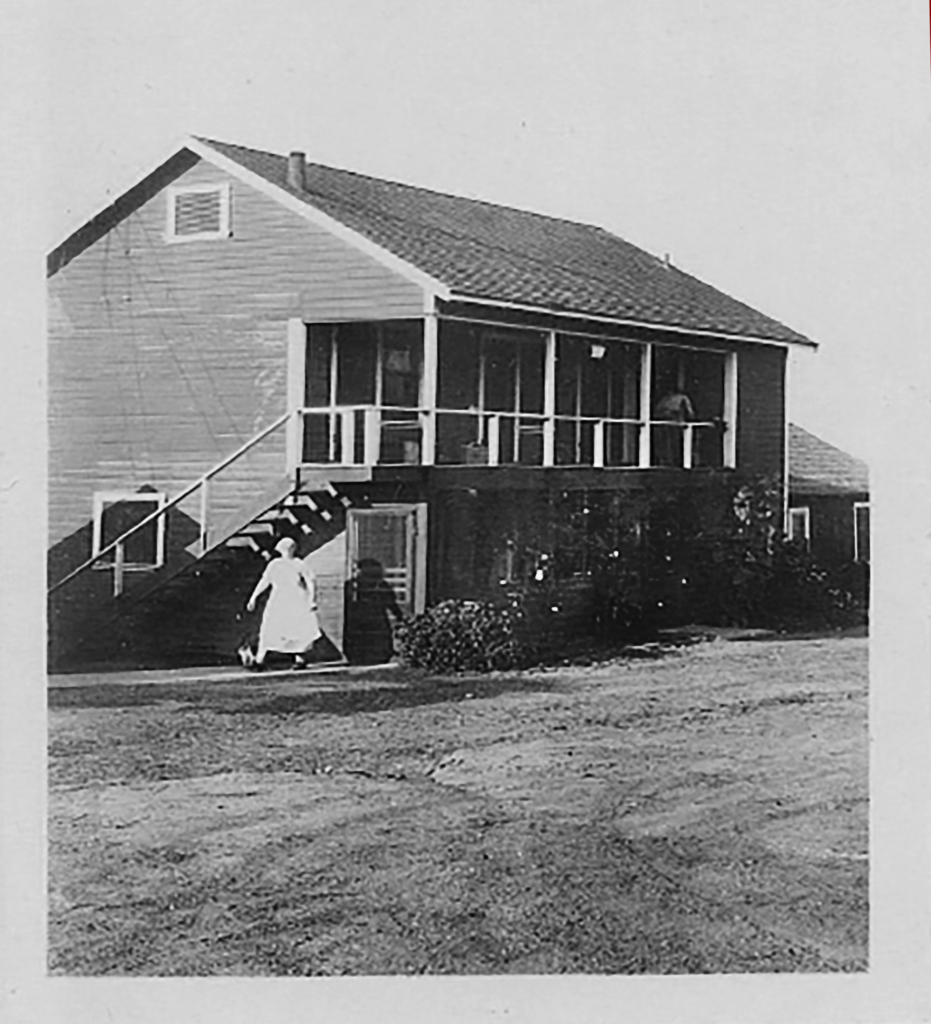
THE BUNKHOUSE
The bunkhouse was a two-story building with three rooms and a toilet room on each
level. The rooms were large and could have easily accommodated 4 or more men each.
There were no interior doors between the rooms. The photo of the bunkhouse was taken
from the side yard of the cookhouse. The bunkhouse photo shows a smaller house to the
right of the bunkhouse. This was the home of Milton and Mary Tyler. At one time
another small house was located to the right of Milton’s house. Hot showers were
provided for the men in the Cook House which had a hot water heater.
[8]
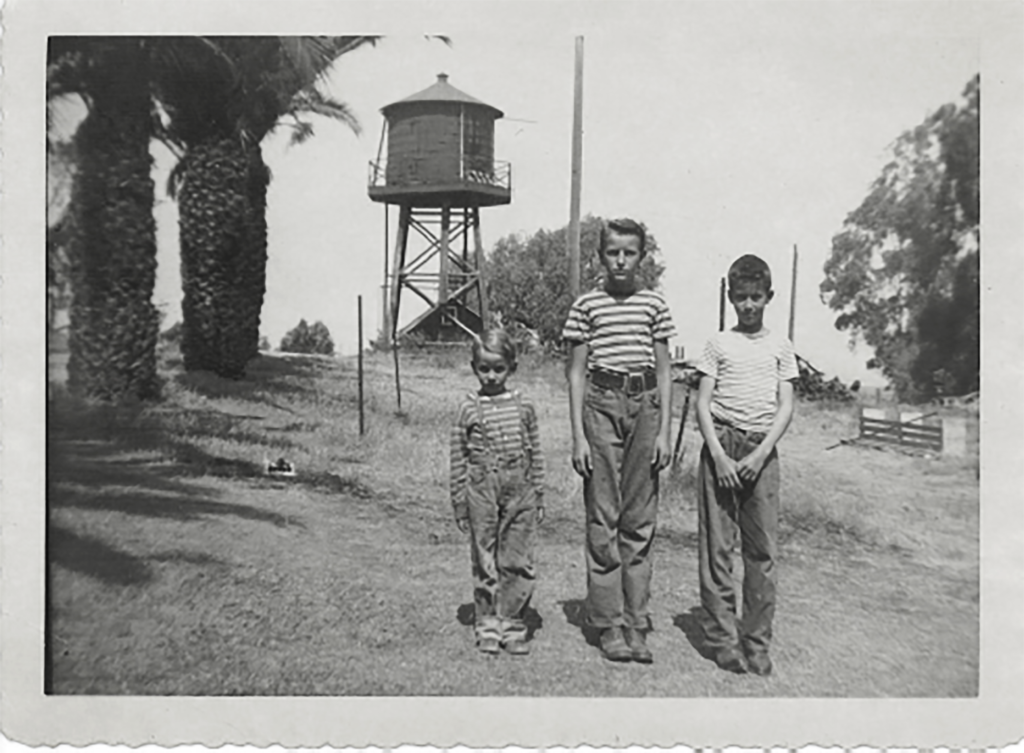
WATER TOWER
The photo of the water tower shows the hen house which is hiding behind the supporting
structure of the water tank. The hens produced eggs which were used in the cook house
kitchen. I suspect that fried chickens also appeared on the cook house dining table. The
water well was to the right of the water tower and the roof of the pump house is just barely
visible to the right of my cousins shoulder. The cookhouse is to the left of the water tower and
is not shown. The three boys in the photo are left to right, my brother Robert Ernest Tyler,
Hugh Tyler and my cousin Eugene Tyler who also lived on the ranch with his father and
mother Milton and Mary Tyler. They are standing in front of the bunk house which it to their
left.
[9]
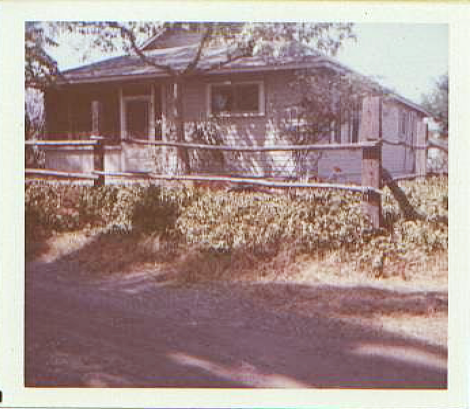
THE COOKHOUSE
The cookhouse was a long narrow building. Looking at the front of the house as
shown in the photo the ranch office was a small room accessible by entering the
screened in front porch. This was the only office space used for all of the
administrative needs of the ranch. The rest of the house was divided lengthwise.
The half behind the screened porch was divided about equally with a large dining
room at the front and a kitchen at the back. The portion behind the office was
divided into a very small bedroom, another larger bedroom, and a bathroom.
Beyond the bathroom was a screened in back porch which had large Ice Boxes for
food storage, a laundry area, and showers for the bunkhouse crew. There was
sufficient counter space for the processing of milk also.
[10]
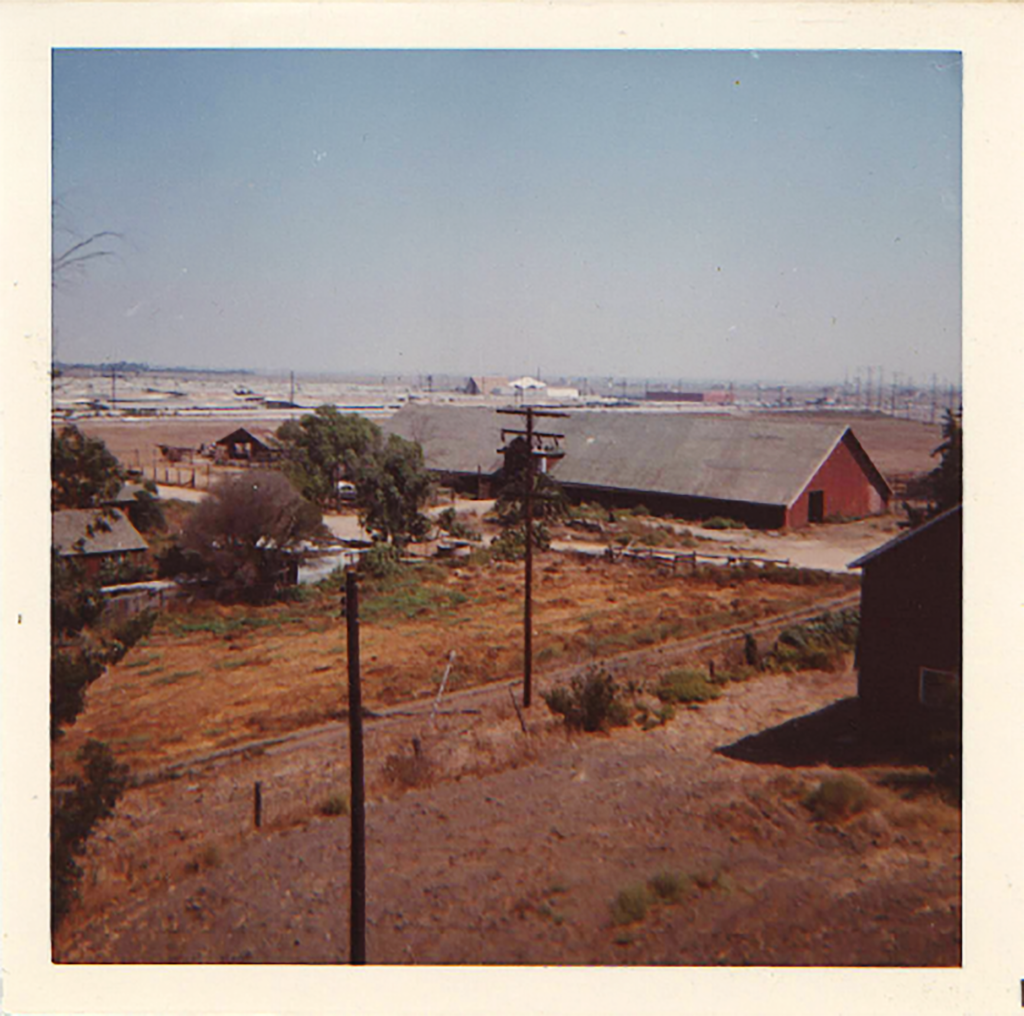
FEED BARN
In this photo, taken from the water tower, the Feed Barn is the large barn at the top of
the photo. By the time that this photo was taken the corrals had been taken down. A
smaller storage barn can be seen at the left end of the feed barn partially hidden by a
tree. The building seen at the far left of the photo is one of three small houses built in
this area for crew housing. The building in the shadow to the right is the bunkhouse. In
the background across the top of the photo is the Rossmoor Leisure World development.
Not seen at the end of the road across from the storage barn was a stud barn.
[11]
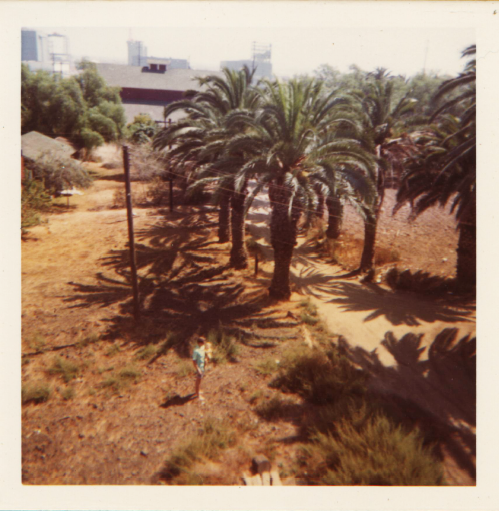
THE HORSE BARN
This photo of the horse barn was taken from the water tower. Looking over the top of
the barn, one can see the area where the Saturn Missile engines were assembled on Navy
property in the mid-1960’s.
[12]
A TEAM OF WORK HORSES
These gentle powerful animals were used for many years along with many other teams
to do necessary work on the ranch. This photo was taken (ca) 1936 in front of the horse
barn. The man in the photo is Hubert Tyler with his son Hugh. It was a very sad day
for all when it was determined that the horses were no longer needed and were sold to a
dog food processing plant.
[13]
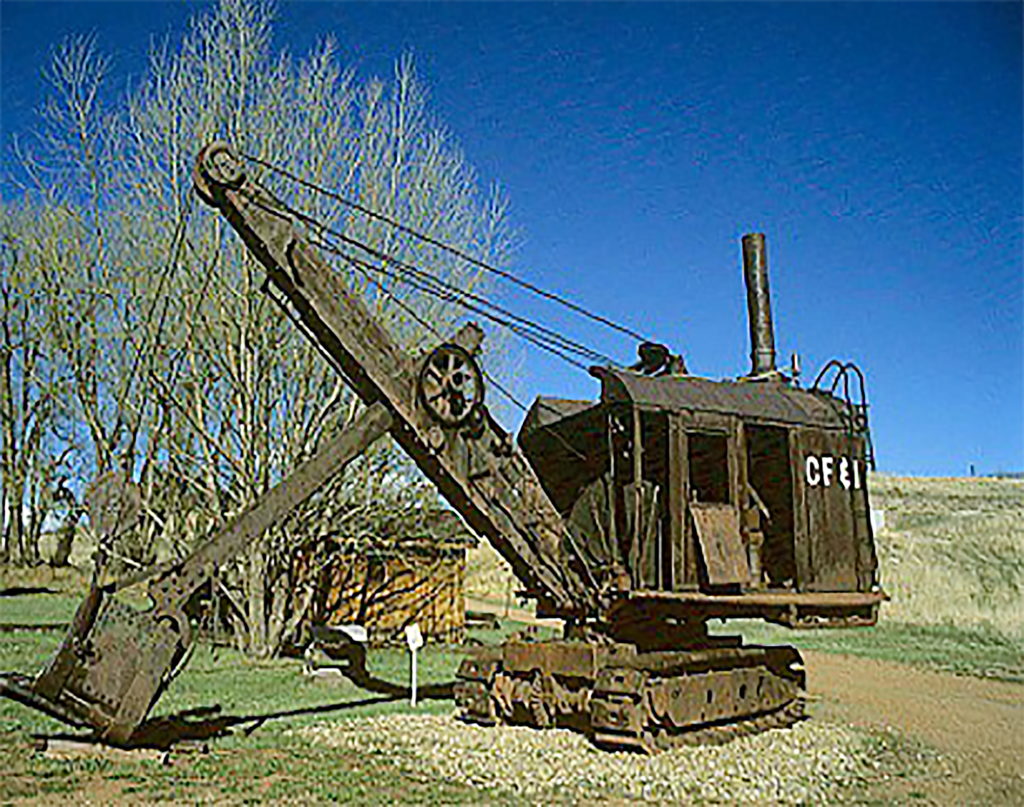
THE STEAM SHOVEL
This photo is included as a close representation of the steam shovel that was used to
create the drainage ditches that made it possible to drain and clear the original virgin
lands that became the Hellman Ranch at Seal Beach. The children who were raised on
the ranch spent many happy hours playing on and in the original steam shovel and were
not happy when it was sold for scrap and hauled away in the early 1940’s.
[14]
The People Who Lived On the Ranch
The very earliest efforts to establish the Hellman Ranch as a cattle feeding operation were to drain and clear the virgin land to enable it to be farmed. A steam shovel was purchased to dig drainage ditches to drain the low swampy land. My father told me that the work was done using the large powerful work horses and teams of mules that the ranch owned. He also told me that the ranch was originally managed by the Bixby Company and that at some time during those early years Mr. Frank L. Crowley was hired to manage the Ranch for the Hellman Company.
Mr Crowley held that job until his death on June 16, 1962. Mr. Crowley hired Mr. Elmer J. Hughes as his foreman to assist in the daily operations while he took care of the financial planning and management. The next phase of the operation was to divide the land into parcels and establish tenant operated farms. Most of the tenants were European immigrants from Belgium. They grew feed crops for the cattle on part of the land allocated to them and a cash crop for themselves on the rest. Many of them raised sugar beets for their cash crop.
Family names of the tenant farmers that I can remember were Quaticar, DeSadaleer, Goosen, DePater and Van DeVelde. There were also Japanese people raising vegetables on part of the ranch near Seal Beach. The only Japanese family name I remember is Frank Abe.
Once the feed crops were being produced cattle feeding began. I consider this the most important phase of the ranch’s history. The bunkhouse was full. All of the houses were being lived in. The Cook House was being used as originally planned and men were commuting to work also. There were many teams of workhorses being trained and cared for by Ramon Attencio.
The ranch also owned riding horses which were trained and cared for by Ambrose Walker. A dairy herd of 10 milk cows was kept to provide the cookhouse with dairy products. These cows were milked and cared for by Luis Cruz.
Other workers that I can remember were Joe Mendoza, Claude Crowell, and his father, known to all as Dad Crowell, who was the steam shovel operator, and Waldow Huffman. By 1938 roads and local housing in Westminster and other nearby areas were developed and the workers who were living in the Bunk House all left. The Bunk House and Cook House were no longer needed. The cattle feeding operation continued until 1942 when the Navy took over most of the farmland. At that time most of the men were laid off and no more cattle were brought to the ranch.
This started the next phase of the ranch history. The ranch became a farm and only three full-time workers were needed. They were my father, Hubert L. Tyler, his brother, Milton E (Dick) Tyler and Ramon Attencio. Luis Cruz got a job with the City Maintenance Dept in Seal Beach and he and his family continued to live in their house on the ranch until they elected to move sometime after 1955. Luis’ wife was named Narcissus, and his children were Richard, Ruth, Mary, Martha, and Lorraine.
[15]
My father, Hubert L Tyler, worked for the Bixby company first and then continued his employment with the Hellman company when they decided to run the ranch themselves
in the early 1920s. Mom and Dad married in 1933 and moved into a house at the No. 2 ranch near Knott Avenue and Garden Boulevard. Soon after that they bought the country store in Barber City and lived there until 1936. Mom ran the store and dad continued to work at the ranch. When I began walking at the age of 9 months they sold the store and moved to a house on the main ranch. Mom was concerned about my safety with all of the traffic on Westminster Blvd.
In 1938 when the ranch cook, Mrs. Freeman, left the ranch my folks moved into the cookhouse. It was my home also until I married and left the ranch in 1955. My folks and my brother Robert Ernest Tyler continued to live there until the property that the main ranch buildings were built on was sold to North American Aircraft/Rockwell company in 1965.
At the time that I was born, in 1935, there were still men living in the bunkhouse and others were living in houses provided by the ranch. In the 3 houses near the Feed Barn
lived the Cruz, Attencio, and Villalobos families. The Villalobos family moved out at the
time that the Navy took over most of the ranch lands. Their house was torn down. Near
the bunkhouse were two more houses. My father’s brother Milton E Tyler, with his wife
Mary and son Eugene, and my family lived in these houses.
When my folks moved into the cookhouse Ambrose Walker moved into the house they vacated. He lived there for several years after which that house was torn down also. The house that Milton and Mary Tyler were living in was in poor condition and was torn down and replaced with a new one in about 1939. While their new house was being built they
moved into the Bunk House. At that time the Bunk House was improved by the addition
of a natural gas cook stove, a hot water heater, a kitchen sink, and a shower in the toilet
room on the ground floor. A wood-burning heating stove provided heat to the two
rooms they were occupying. Milton and Mary Tyler moved into their new house and
lived in it until the early 1960s when they moved to a home they purchased in
Westminster, Calif.
The improvements to the bunkhouse led to its use by others who were in need of a place to stay. Mary’s stepmother Ella Black was widowed in Tennessee and moved into the bunkhouse in about 1942 with her son and 5 of her daughters. They stayed in the bunkhouse until 1947. Shortly after that my dad’s sister
Zula and her husband Wilbur Dunkin moved to California from Montana and stayed in
the bunkhouse for a few months while they got established in new jobs and housing in
Long Beach. The next occupant was my Grandfather Arthur E Tyler. He arrived from
Tennessee in 1949 and lived in the bunkhouse until his death in 1961.
15
The Cook House was the business center for the ranch. The ranch office was a small
room at the front of the house accessible from the screened in front porch. Beginning in
1938 when my family moved into the Cook House we shared the ranch office telephone
which had an extension into the kitchen. When business calls came into the office Mom
would be there to answer the phone. Each day 6 days a week mom would prepare a
large hearty meal and serve it family style to her family, Mr. Crowley, Mr. Hughes, and
any visitors that happened to be doing business with Mr. Crowley at lunchtime. When
my grandfather arrived from Tennessee he ate lunch and dinner with us. There was
always a rich gravy, plenty of bread, meat, vegetables, and a dessert to finish up with.
Lunch was served at Noon and the old RCA console radio would be turned on and tuned
to radio station KFI so that all could hear the daily news. The newscast would last
fifteen minutes and the next fifteen minutes or so would be spent discussing the news.
Mr. Crowley was a staunch Republican and my grandfather was a very strongly
opinionated Southern Democrat. With Eisenhower as President, the discussions were
often very interesting. Grampa Tyler had lived on and farmed a fifty-acre homestead
near Morristown, Tennessee his entire adult life. This was the name he wanted to be
known by and no one ever referred to him as Arthur. There were still ranch owned
riding horses, a burro, Mr. Crowley’s thoroughbred racehorses, two milk cows, and
horses that were being boarded on the ranch by Captain McKinney who was the
Commander of the Seal Beach Naval Base, and by Mr Gus Walker, President of the
Farmers and Merchants Banks of Long Beach. Mr. Walker and his sons Kenneth,
Richard, David, and Donald played polo on Sunday afternoons with Frank Vessels and
others in Garden Grove. When Ambrose Walker left the Ranch he and Mr Crowley
formed a partnership to breed, train and race thoroughbred racehorses. Grampa also
raised pigs and cared for the calves produced by the milk cows until they were ready to
be butchered. He earned his keep and was well respected for his constant attention to the
welfare of all of the animals that he attended to.
The Life of a Farmer and His Family
The work hours for the employees were from 7:a.m. to 5:p.m. six days a week. After
the Naval takeover of most of the ranch property, two milk cows were kept to provide
milk for the Tyler families. The cows had to be hand milked twice daily seven days a
week. My father and his brother Milton shared this job. This meant that they had to be
up and out very early in order to start work at 7:a.m. and their day was extended after
5:p.m. to do the afternoon milking. Dad would be up at 5am to prepare and eat his
breakfast then go do his part of the milking. In the afternoons he and his brother would
do the milking after returning from their fieldwork for the ranch. I occasionally helped
with this chore if dad or his brother were otherwise occupied Two cows can produce a
lot of milk and the milk that was not shared with others on the ranch had to be processed
[17]
into cream, butter, and sometimes into cottage cheese. We used some of the fresh cream to make a very rich ice cream. One of my many chores was to operate the hand-cranked milk separator. This machine separated the cream from the milk. Most of the cream was turned into butter with a hand-cranked butter churn. I did this also. The skim milk and the buttermilk were fed to the chickens that mom kept in the chicken house for eggs and for the table. My chores included keeping the chicken house cleaned out and mowing the yard around the house. Everyone had work to do and it was usually done cheerfully. Life on the ranch was good for us and we enjoyed the satisfaction of doing a good job of all that needed to be done.
Dad raised a large vegetable garden every year. The produce from the garden was eaten fresh when available and because of the large quantity of corn, green beans, tomatoes, and other vegetables, mom did a lot of home canning. Each year the folks would drive to Pomona to buy several large boxes of peaches. These were home canned also. I helped with the preparation of the fruit and vegetables for the canning process and of course with the kitchen cleanup. One year dad raised a lot of cabbage. Mom turned it
into sauerkraut by letting it ferment in large crocks on the back porch. The odor produced by this process is unforgettable and dad never raised cabbage again.
When the cattle ranching ended and farming began, the land which became Rossmoor Leisure World was planted in barley, alfalfa and Lima beans. The alfalfa was cut green and sold to dairies in the Artesia-Cerritos area, later known as Dairy Valley. Gradually the irrigation system was expanded so more alfalfa could be planted and a continuous year-round crop was made available to the dairy herds. This was a very profitable operation
for the Hellman Ranch and could be accomplished with a minimum of hired help and
equipment. The dairymen came to the ranch with their own trucks and hauled the green
hay themselves. Dad and his brother would cut the alfalfa in the afternoons and the
dairymen would come in the very early morning hours to load and haul it. The men,
including Ramon Attencio, would spend their mornings with irrigating recently cut
alfalfa or working on land for other crops. Ramon would continue to monitor the
irrigation when the other men were cutting and raking the alfalfa. At times when Dad’s
brother was occupied with other tasks and it appeared that Dad would be working later
than usual, I would take another tractor to the field where dad was working and help him
finish up. I was taught very early how to operate the farm equipment responsibly and I
never misused the privilege. I started helping dad at the age of 7 years and by the time
I was 12, I could operate both trucks and all of the rubber tired tractors. When I was
fifteen years old I was paid to drive one of the caterpillar tractors to plow a 100 acre
field. I was very happy to finish that dusty, noisy, boring job. I worked for the ranch for
5 summers to pay my way through high school and college. Such was the working life
of a farm boy.
[
[18]
Play Time and Recreation
There were many children living on the ranch when I was growing up. We usually
played together, but we could individually seek seclusion in one of the many barns when
we wanted to be alone. There was always a riding horse available for our use and we
were allowed to ride it at any time that we wanted to. Mr. Crowley somehow managed
to obtain a well-trained burro that we could ride also. Other activities included softball
games in front of the horse barn and we often played “hide and go seek” and “tag” and
other games created in our own imaginations in the barns. When there was baled hay in
the hay storage barns behind the tool shed we would sometimes move the top one or two
levels of bales around to form tunnels and caverns to play in. These hay barns usually
had long heavy ropes in them which were used to lift the bales from the truck, which
hauled them to the barn, to the top of the stack. There were pulleys for the ropes to be
fed through to aid in this process. What a wonderful opportunity these ropes and
pulleys offered to the imaginative minds of children who used them for swings when
they were not being used for their intended purpose.
The Last Work Horse
When using the ropes to lift the bales to the top of the stack, something had to be used to
pull on the rope. Initially, a tractor was used. It would pull the rope until the two bales
attached to the rope with large hooks were high enough for the top men to catch them
and drag them into the proper position for storage. The tractor would then back up
toward the barn to lower the hooks back to the truck to pick up two more bales. I
noticed one day that Mr. Crowley was watching this operation and shaking his head
slowly. A few days later a large workhorse was delivered to the ranch. The next day
the workhorse replaced the tractor. She was properly harnessed and led to the hay barn
where she was carefully taught how to do the required work. Ramon would wait until
my father who worked on the truck would yell the word “OUT”. Ramon would then
lead her out away from the barn to lift the bales. When the bales were high enough dad
would yell “WHOA”. Ramon would stop her outward travel and hold her in that
position until dad would yell “BACK” Ramon would back her up toward the barn to
lower the hooks again. Ramon would then stop her at the same position that the process
had started from. The horse soon began following Dad’s commands without Ramon’s
guidance. Ramon was not needed after about two hours of teaching the horse do what
was required. At noon that first day the very large noon whistle from the navy base
sounded at the same that the horse was being unharnessed for the noon lunch break. She
was taken to the horse barn for food, water, and rest. The next day when the noon
[19]
whistle sounded she was ready for her break and stopped work immediately. Using the
horse instead of the tractor eliminated the tractor, the fuel it burned, and the salary of the
man who was operating it. This was a very cost-effective solution for the ranch.
The old workhorse was still on the ranch in 1955 when, on a foggy night, someone ran
a car through the pasture fence which ran along Seal Beach Blvd. The horses being
boarded there wandered onto the road and had to be herded back into the pasture. I put
a halter on the workhorse who although in the pasture was very close to the horse barn
corral and thus easily approached. With the halter on her I jumped up on her and rode
her bareback to round up the horses and herd them back into the pasture. With the
horses back in the pasture I dropped the rope of her halter to the ground and proceeded
to make a temporary repair of the fence. The old workhorse never moved and when I
jumped up onto her back again she returned me to the horse barn. This was my last
horse ride on the ranch. I found work in an electronic equipment manufacturing plant,
married, and moved into an apartment in Garden Grove. My days on the Ranch ended at
that time.
Related articles
- New Hands at the Ranch (OC Register, August 2006)


